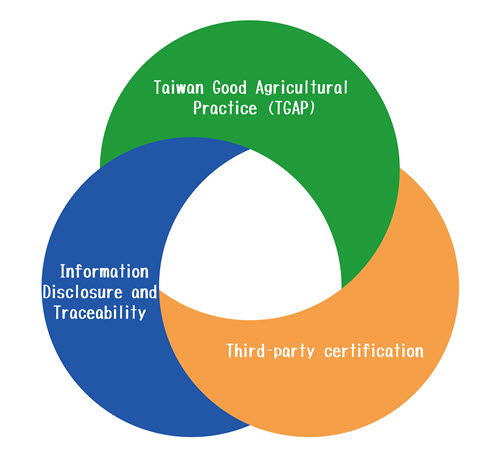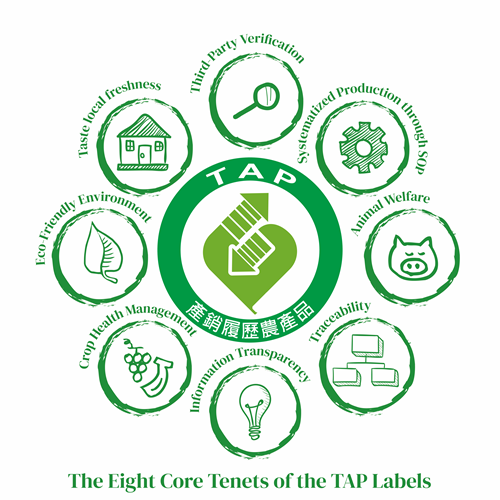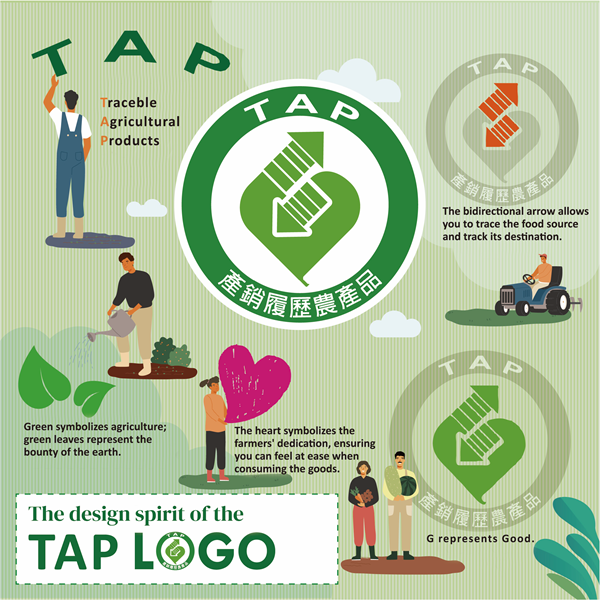All About Taiwan’s Traceable Agricultural Products
I. Introduction
Under the Traceable Agricultural Product (TAP) System, agricultural product operators follow standardized operating procedures, implement Taiwan Good Agricultural Practices, disclose their own management information for traceability, and are certified by a third-party certification bodies during the production and distribution of their products, to offer consumers safe agricultural products and promote sustainability and resource recycling in the agricultural sector.
The TAP System is promoted by the Ministry of Agriculture (MOA) in accordance with the Agricultural Production and Certification Act ("Act"), and has been in effect since 29 January 2007, to offer consumers guaranteed safe agricultural products and promoting sustainability in the agricultural environment. As agricultural product quality management and safety advanced, the Act was amended on 25 December 2009 and came into effect one year later. The TAP regulations were adjusted at the same time, with three main objectives: improve the quality and safety of agricultural products; optimize certification quality; protect consumers’ rights and interests. These regulations have since been refined from time to time.
When purchasing TAP products, consumers can scan the QR code on the product label or enter the TAP code into a search box at the "Taiwan Agriculture Food Traceability System Website" (https://taft.moa.gov.tw) to access public information such as the operators handling the agricultural product, the certified items, the certification body, and the validity period of the certification.
The public traceability information on TAP products confirms that a certification body has visited the production, packaging, distribution, and processing sites on your behalf to verify whether the production processes comply with regulations and whether the TAP records are consistent with what is said, written, and done, and also to sample products for inspection to check the food safety for consumers. This way, falsification of production and distribution history information is prevented, and the quality and potential risks along the production process are controlled.
To understand the production and distribution records, we can look at the system from three angles: "transparent and traceable information", "Taiwan Good Agricultural Practice (TGAP)", and the "third-party verification system".

Three Angles to Enter the Traceable Agricultural Product System
A. Information Disclosure and Traceability
Consumers can enter the traceability code of TAP products by scanning the QR Code on the label or entering the code at the "Taiwan Agriculture Food Traceability System Website" (https://taft.moa.gov.tw) to access information on these agricultural products such as the operators, certified items, certification bodies, and the validity periods of the certifications.
The key difference between the TAP information and the general production records is that this traceability information has been checked by a third-party certification body. This makes the security and reliability of the TAP product information more reliable.
When agricultural product operators obtain TAP products as raw materials for packaging, distribution, or processing and apply for TAP records certification, they must comply with the certification standards and relevant regulations and truthfully record the product items, operation times, raw material sources, operation flows and content, product shipment times and quantity of each batch, to create traceable information on the production and distribution process.
The records of the production processes must be posted in the "Agricultural Production and Distribution Traceability Information Management System" for inspection by the competent authorities and certification bodies at any time. Conformity between the system’s data and the actual production conditions is the focus of the certification bodies during their inspections. At least once a year, each certification body will conduct a tracking inspection to verify whether the agricultural product operators comply with the certification standards and regulations. The conformity between the system’s data and the actual production conditions is the focus of these inspections. The competent authority may also conduct random inspections at any time to ensure the safety of TAP products.
Consumers may use the information disclosure and traceability features to check the background of TAP products and their producers when purchasing TAP products and choose agricultural products that are more secure and safe.
B. Taiwan Good Agricultural Practice (TGAP)
The production of TAP agricultural products must comply with the "Taiwan Good Agricultural Practices" (TGAP). TGAPs consist of operational standards developed by government agricultural research units and experts and scholars based on agriculture, fisheries, livestock, forestry, growth characteristics of various items and production management methods in Taiwan. These standards’ content and structure include flow charts, a risk management table, a checklist (known as “chart, table and list”), and related schedules. For example, the risk management table lists the hazardous factors that may cause risks at each stage of the production process, the causes of those hazards, the countermeasures to be taken, and certificates and documents presented in a table.
Agricultural product operators can effectively manage the production process using the “chart, table and list” to enhance their pesticide safety, food safety, environmental hygiene, and sustainable production. In recent years, the government has also invested in the consolidation of specific TGAPs for vegetables, fruits, and grains, making it easier for producers to comply with these standards.
To promote sustainable agriculture in Taiwan, the Department of Agriculture (DA) of the Ministry of Agriculture (MOA) has introduced the TGAP PLUS - for Vegetables, Fruits, And Grains, and Rice in 2022 and TGAP PLUS - Special Crop - Sugarcane in 2023 on top of the existing TGAPs. MOA also raised the requirements for Integrated Crop Management (ICM) and Integrated Pest Management (IPM), stressing the importance of integrating these into TGAP and emphasizing the spirit of the four major areas: Good Agricultural Practices (GAP), Food Safety, Labor Safety, and Environmental Sustainability.
A number of sustainable agricultural production indicators were added to the existing TAP records, which offers domestic agricultural product operators opportunities to leverage sustainability as a way to strengthen their product value and connect with the international community. Agricultural product operators may adopt these indicators to practice and demonstrate sustainable agricultural production to help safeguard the global village.
C. Third-party certification
"Third-party certification " is key to the TAP System. A “third party” is defined as "a third party with no common interest". The third-party certification body, based on fairness, checks the production processes of agricultural products, certifying that the agricultural product operator meets the requirements of the TAP System (e.g., government regulations, TGAP). It then issues a certificate stating that the quality and safety of the agricultural products comply with the requirements of the TAP System.
After the agricultural products have passed TAP certification, the agricultural product operators may use the TAP label and basic information on the production and certification on their products to help consumers identify their products—all in accordance with the "Agricultural Production and Certification Act" and the "Regulation on the Labeling of Certified Agricultural Products".

The Eight Core Tenets of the TAP Labels
II. Introduction of the TAP Label

The features of the TAP label are as follows. Since it is a uniform identification mark for certified products, regulations strictly stipulate the color, font, graphic shape, and proportion of the label. Agricultural product operators are not allowed to change it, except for the label’s size to fit the product packaging or container surface area, provided that the label’s diameter is at least 1.7 centimeters, to keep it recognizable for consumers:
A. The outer ring has the words "Traceable Agricultural Product" below and "TAP" on top, where TAP is the abbreviation for "Traceable Agricultural Product".
B. In the center sits a green symbol:
(1) Green leaves, representing that TAP agricultural products are gifts from nature.
(2) The two-way arrow symbolizes that TAP products can be traced back to their sources, and vice versa.
(3) The G shape represents that TAP agricultural product is a Good Product, a model in the agricultural sector.
(4) The heart shape represents the farmers’ dedicated hearts and minds as well as consumers’ peace of mind, confidence and reassurance derived from the quality of TAP products.
(5) The thumbs-up represents the good reputation of the TAP System and the pursuit of excellence.

TAP agricultural products must carry a clear label and Chinese language and common symbols on the packaging or containers to convey the following seven items of information to help consumers notice and access the traceability information:
1. Product name.
2. Names of the raw materials. (If the product is made from a single raw material whose name is identical to the product name, this can be skipped.)
3. Net weight, volume, quantity, or measurement.
4. Name, telephone number and address of the agricultural operator.
5. Place of origin. (If the address of the manufacturing factory or inspection site sufficiently indicates the place of origin, this may be skipped.)
6. TAP label, traceability code and name of certification body.
7. The website address or QR code of the Taiwan Agriculture Food Traceability System Website (https://taft.moa.gov.tw).
To meet the need for various types of TAP labels and to enhance the international visibility of Taiwan's agricultural products with TAP labels, there are also English and Japanese label versions available for agricultural product operators to use. The TAP labels only contain concise information. Therefore, if agricultural product operators choose to use an English or Japanese label version, these can only be used for exports and cannot be used domestically.
III. Development of the Traceable Agricultural Product System
Since 2003, the Traceable Agricultural Product Program has been promoted on a trial basis in dozens of TAP courses and agricultural organizations across the country to assist farmers in keeping records of their field work and managing the safety and quality of their products. In 2005, the Traceable Agricultural Product Demonstration Program was expanded and a coaching committee and working group were established.
In January of 2007, the Agricultural Production and Certification Act was promulgated, and related sub-laws and implementation regulations were enacted within ten months, marking the start of the TAP era in Taiwan's agricultural sector.
In 2008, the Taiwan Good Agricultural Practice (TGAP) was adopted to set production standards for all types of agricultural products. Under a third-party certification system, independent certification bodies conduct fair and transparent checks on the production processes of certified or to be certified products, to assure that the producers have a clear understanding and sufficient capabilities to properly manage the production processes of their TAP-certified products.
In 2011, the Traceable Agricultural Product Promotion Program was implemented to roll out the TAP labels to all parts of the country and to strengthen the awareness and adoption of the TAP System among agricultural producers, processors, and sellers. In the same year, the TAP Masters Recognition Program was launched.
In 2015, the "Comprehensive Traceable Agricultural Product Promotion Program" was implemented to expand the scope of the TAP System to a wide range of agricultural products, such as fruits and vegetables, livestock and poultry, aquatic products, and forest products, and to further strengthen the implementation and management of the TAP System.
In response to the numerous food hygiene and safety incidents and increased consumer demand for agricultural products and food, the government wished to build a more comprehensive traceability system and a three-tier quality control mechanism. Considering that the old law had not been amended since its promulgation and implementation in 2007, the government initiated an amendment to the Agricultural Production and Certification Act and related sub-laws and circulars. The key points of this amendment included: privatizing the TAP certification system; allowing the competent authorities to announce specific certification systems for specific industry needs; specifying the information items that operators should put on TAPcertified products; and imposing a time limit for correcting labeling violations.
The TAP System has gained recognition and popularity in Taiwan and has become an important management measure for assuring the quality and safety of food and agricultural products. The government is committed to improving and innovating the TAP System to enhance the quality and safety of agricultural products, protecting consumer rights, and promoting environmental sustainability, so that the agricultural sector in Taiwan can progress towards the international net-zero trend of the new era.

